by Winding Pathways | Aug 15, 2024 | (Sub)Urban Homesteading, Chickens
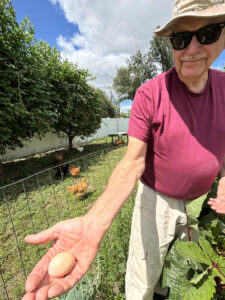
First eggs are a delight to find.
August 26th brought an unexpected and delightful surprise. We found an egg in our coop! Bringing the garden season’s first tomato, cucumber, or summer squash into the kitchen is always an event to celebrate, but it doesn’t compare to the excitement of finding the first egg.
We were expecting eggs soon, but not so soon. Our tiny baby chicks arrived from Hoover’s Hatchery on April 10th. It normally takes a female chick about 20 weeks to mature and lay her first egg. Some old-fashioned breeds don’t start laying until they’re 24 or even 30 weeks old.
We expected our small flock to start laying around Labor Day, but our first egg came when one of our pullets, or young hen, was only 18 weeks old. It was surprising.
Odd Shapes

Sometimes calcium does not form on eggs.
A hen’s first eggs are small and sometimes shaped oddly. Sometimes these early eggs can be found in stores marked as, “pullet eggs”. After a few weeks of laying, her eggs reach medium or large size. Sometimes early in a hen’s laying life, she’ll lay a whopper of an egg with two yolks. It’s startling to crack an egg into the frying pan and discover that second yolk. As her reproductive system matures her eggs will be more uniform in size, shape, and have hard shells, and eggshell tint.
Best Breeds
Hundreds of chicken breeds have been developed since the species was domesticated thousands of years ago. They come in a vast array of size, feather color, temperament, and productivity. The best breed is the one its owner likes.
Our 12-hen flock at Winding Pathways is a mix of egg laying superstar breeds and traditional breeds that don’t lay at a furious pace. We like them all. It’s hard to beat Rhode Island Reds, Barred Rocks, or California White breeds for early and plentiful eggs. We have a few but round out our flock with Brown and White Brahmas, Mystic Onyx, Buff Cochins, and a Rainbow.
Fall Chicks
Most families buy chicks in the spring, but fall is also an ideal time to start a flock. Babies hatched in September begin laying by January or February’s baking season.
For detailed information on breeds and chicken care visit Hoover’s Hatchery Website.
It includes blogs filled with tips and Facebook Live Videos filmed at Winding Pathways.
by Winding Pathways | Aug 8, 2024 | (Sub)Urban Homesteading, Foraging
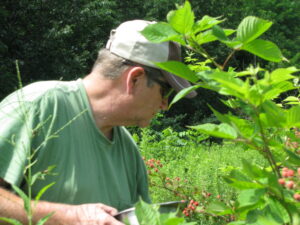
Summer foraging
Rich enjoyed foraging blackberries on an August morning. We love harvesting and eating wild foods gathered on our property at Winding Pathways and in area parks. Every once in a while, our foraging forays yield a bonanza. That is what happened on Rich’s walk. Fortunate Foraging Blackberries
Just after rounding a bend on a Wanatee Park trail, he spotted a patch of wild blackberries. We love them, but they aren’t a reliable food source. To yield juicy fruit the thorny plants need regular rain. In most years the canes sprout springtime blooms that transform into tiny fruits. Then comes a dry spell and the promising fruit dries into inedible seeds.
It’s been years since we enjoyed abundant blackberries, but 2024’s frequent rain promised a heavy crop. That’s what Rich found on his morning walk. Canes were loaded with berries that came with picking bonuses. So many were ripe that picking was easy and the hordes of hungry mosquitoes that normally guard the fruit must have had the day off. Picking in an unusual August cool breeze was a pleasure.
Species of Blackberries
Wild blackberries of several species grow across much of the United States. Most ripen in mid-summer. They thrive in sunny clearings and often quickly colonize when trees blow down or are harvested. A 2020 derecho felled thousands of trees in our area, letting the sun reach soil that had been in the shade for decades. Black raspberries and blackberries began growing the next year, as if by magic, but summers were dry so they didn’t make a crop. Four years after the storm and eight inches of July rain produced an amazing crop.
Unlike many foraged foods that have toxic lookalikes, there are no harmful plants to confuse with blackberries. It is an ideal wild food for novice foragers to start with.
Eating Blackberries
We love eating fresh blackberries. Add a dribble of milk and maple syrup to a bowl and enjoy them. They’re delicious in oatmeal and freeze well. A friend makes the world’s tastiest blackberry pie that’s yummy when served with vanilla ice cream.
Rich encountered a man who’d picked at least two gallons of the small fruits. “What do you do with them,” he asked, and the fellow picker responded:
“I put them in a big pot with some water and sugar and boil it until the berries soften. Then I run them through a cheesecloth filter to remove the seeds and skin. I let it cool down, invite friends over, and mix vodka into the berry juice. It’s just delicious!” he enthused.
Information on blackberries can be found online or in printed books, but a fun website is Spoon University. It’s loaded with foraging information from a young person’s perspective.
A Picking Tip
Blackberry canes are armored with fierce thorns. Hungry mosquitoes often pounce on human pickers. Wear long-sleeved pants and a sturdy shirt. Bring along insect repellent.
Have fun picking and eating a delicious wild bounty of the land.
-
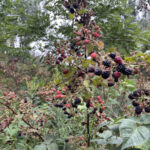
-
Abundant crop
-

-
Interesting ripening
-
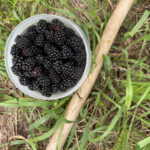
-
Delicious container
by Winding Pathways | Jul 25, 2024 | Nature, Travel/Columns, Water Resources

Tumbling waters
There it is! A Waterfall. There’s a second. Wow, just upstream is a third. Three waterfalls in one Iowa stretch of stream! How can that be in such a flat state?
Waterfalls bring mental images of water tumbling down steep hillsides where it plunges hundreds of feet downward. We’ve marveled at tall falls in many states including Hawaii, Nebraska, Washington, Indiana, Minnesota, New Hampshire, and New Jersey. But Rich had discovered the waterfall trio in an unexpected state – Iowa – and in an equally unexpected part of the state.
-

-
Water tumbles through a narrow cataract.
-

-
Indiana surprise
-

-
North Shore Falls
Briggs Woods County Park Delight
Amid north central Iowa’s vast level corn and bean fields he discovered the three cascades after a short hike near Webster City. More than rushing water caught his eyes. Fish were trying to leap up the rushing torrent. “It brought back memories of salmon leaping Brooks Falls in Alaska. These were small fish of an unknown species. Watching them was great fun,” he said. The three falls are close together in Hamilton County’s Briggs Woods Park and all it takes to enjoy them is a short hike on an easy trail.
Driftless Area
Iowa isn’t flat. Mostly it’s rolling terrain, but the state’s northeast corner features downright steep slopes. It’s the Driftless area, where most of Iowa’s falls gurgle and tumble down into clear running trout streams.
Touring Iowa’s Waterfalls
Seeing the Briggs Woods falls gave us a waterfall bug, so a few weeks later we drove north from our Cedar Rapids home. A region of Karst topography, the Driftless boasts dozens of clear water trout streams and several impressive falls.
-

-
Karst topography helps create waterfalls.
-
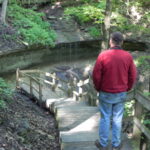
-
Bridal veil falls, at Pikes Peak
Decorah Area
Decorah is Iowa’s waterfall epicenter. Twin Springs bubbles quietly from the ground and flows down past a campground. Siewer’s and Dunnings Springs hurl an impressive amount of cool clear water over rocks close to downtown. (Note, the travel Iowa site uses an apostrophe (‘) for Siewer’s Spring but not for Dunnings). It’s easy to park close to all of these. Viewing nearby Malanaphy Springs is worth the mile walk. It’s the best known of several falls that send water to the Upper Iowa River.
-

-
Cooling waters.
-

-
Water tumbles from the ledges
-

-
A popular stop for canoeists on the Upper Iowa River.
-

-
Hike through quiet woods.
Other Waterfalls
Other Waterfalls? Yup. Depending on who you ask and what you consider a waterfall, the Hawkeye state has dozens of them. Many aren’t natural waterfalls. Many are human-made cascades tumbling down a dam spillway, but the ones mentioned above are genuine nature-made falls.
Benefits of Seeking Out Waterfalls
We love falls for their beauty. Visiting them has a side benefit. They are in Iowa’s most beautiful terrain. A waterfall viewing trip gives the opportunity to see these unexpected Iowa sights, hike challenging trails, enjoy local eateries, and overnight in nearby campgrounds or one of the dozens of bed and breakfasts scattered about rural and small-town Iowa.
Where to Find Waterfalls
A helpful resource for finding falls is Travel Iowa – 14 Wonderful Waterfalls in Iowa.
by Winding Pathways | Jul 11, 2024 | Nature, Travel/Columns, Wonderment
Winding Pathways is near the edge of town, making it easy to drive into the country and enjoy rural views. Mostly our car traverses Iowa’s abundant corn and soybean fields, but two recent trips gave exceptional views of different vegetation that bloomed in bright lavender under the June sun.
The Lavender Farm

Entry to Calyx Creek
One recent June afternoon as we drove through conventional crops an amazing and delightful view appeared. Shades of purple and stunning white blanketed the undulating land accenting the deep green of cultivated crops. We had discovered Calyx Creek Lavender and Lodging a few miles west of North Liberty, Iowa. Rows of lavender in various stages of growth surrounded us as we entered the main building to find various products made of this unusual plant.
The warm, calming fragrance of the oils of this subtle herb wafted through the shop. Dried bunches hung from racks. Informational signs in front of gleaming machines shared highlights of the distillation process. Soaps, oils, candles, carpet freshener, lavender-infused stuffies and slippers, beverages, and tasty treats beckoned visitors to sample and buy. A lemonade mix was a hit among patrons on this warm summer day. “It smells so good inside, and this lemonade is super!” commented one man, cupping the cool drink in his hands.
-

-
An array of products awaits.
-

-
Slushys are popular.
Tours and Lodging
Part of the experience includes tours, opportunities to harvest and enjoy in your own home, and overnight lodging!
We walked among fields of blooming lavender to two of the several cabins available for rent. The two, built on pedestals, are well-equipped. All the lodgings offer a chance to “get away” while being close to nature. We climbed the stairs, sat on the small cabin’s deck, and took in the rural views of expansive fields of lavender. Peace flowed through us.
-

-
Strolling through lavender fields
-

-
Peaceful overnights
Calyx Creek Lavender and Lodging is a fun place to visit, especially during the early summer blooming time. More information at: Calyx Creek LLC, 1722 255th St. NW, Oxford, IA 52322.
Phone: (319) 900-5992
Where Does Lavender Originate?
Lavender is native to the Mediterranean Region of southern Europe and Northern Africa. It has so many uses that it has been planted around the world. It has become problematic in Australia but is a valued product in North America. Lavender has a long, documented, and storied history with applications for improved health, reducing anxiety, moderating the effects of bug bites and burns, and as an antiseptic/anti-inflammatory agent. The latter is useful in the flu season. Gardeners can grow lavender at home. A helpful resource on how to grow it is at Garden Design.
More Rural Views
The fields of lavender at Calyx Creek are carefully groomed, providing a contrast to our discovery the next day. Secondary roads stairstep through Iowa, replete with rural views of corn, beans, oats, cattle, and goats. We were making our way to a reconstructed prairie south of Waterloo, Iowa
The Irvine Prairie

A happy duo.
That day Cathy Irvine led us through her prairie dotted with pale purple coneflowers, purple prairie clover, and blooms of different hues. Common yellowthroats serenaded us as red-winged blackbirds winged around this amazing place.
We admired the beauty of one of Iowa’s largest reconstructed prairies and were humbled to have Cathy Irvine share part of her day with us. Some people are so inspiring. She’s one.
After years of conventional farming, her vision took her land in a different direction. She’d turn the clock back and restore her land to how it looked and functioned before the first plow turned the original prairie into row crops. She didn’t do this on a whim. For decades Cathy had thought about, researched, attended programs on, and connected with experts on prairies. She knew that reconstructing the native habitat with its diverse plants and animals was right to do.
-
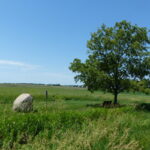
-
Glacial boulders are part of the landscape.
-

-
Contrast
Collaboration
Working with the Iowa Natural Heritage Foundation and the University of Northern Iowa Tallgrass Prairie Center she placed much of her farm in conservation easement and collaborated on restoring it to its native vegetation in honor of her late husband, David. Being in a conservation easement means that it will remain a wild and gorgeous prairie forever, no matter who might own the land in the future.
Iowa’s Rich Heritage
Iowa’s original prairie hosted upwards of 300 plant species on each acre that agriculture transformed into vast monocultures of soybeans and corn. Cathy’s land was in row crops until she decided to give her property to the Tallgrass Prairie Center under a conservation easement. Starting in 2018 the Prairie Center began planting upwards of 100 native species an acre and followed it up with prescribed burning, weeding, and even plugging in more native species.
Cathy, the Tallgrass Prairie Center, and the Iowa Natural Heritage Foundation welcome visitors to experience what much of Iowa once looked like. It’s a place to enjoy dancing prairie grasses and forbs on a breezy summer day, listen to birds trilling across the expanse, watch butterflies forage on blooms, and be inspired by the quiet beauty resulting from a transformation springing from Cathy’s vision and cooperative effort.
The Prairie is located at 1173 55th Street, Dysart, Iowa. Several mowed trails radiate outward from a small parking lot. A bench nestled under a spreading tree offers shade and a place to reflect.
-
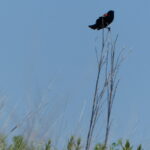
-
Calling out territory
-

-
colorful forbs
-
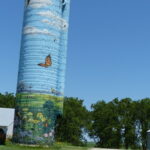
-
Colorful silo
Best Times To Enjoy Prairie Flowers
Prairie flowers bloom throughout the growing season but during midsummer’s heat, the colors are most amazing. However, the prairie is magical in any season. We enjoy our small reconstructed prairies through all seasons and especially in the summer months.
The Lavender Farm meticulously cultivates a useful plant not native to Iowa and the Irvine Prairie carefully stewards a rewilded prairie. Both are gorgeous.
For more information, visit the Tallgrass Prairie Center and the Iowa Natural Heritage Foundation websites.
The Color Purple
Our eyes had the good fortune to view purple lavender one day and purple prairie flowers the next, but purple is a tricky color, at least for some people. Like around 10% of men and boys, Rich isn’t able to see it or see it as folks with normal color vision can. “Red and shades of red are hard for me to see. Purple is nearly impossible. It seems odd but I can see the color but know it looks very different to me than to most folks. If someone asks me what purple looks like I have to say, I’m not sure since I can’t really see it,” he said. “Fortunately I can see blue and yellow prairie blooms and magnificent butterfly milkweed flowers that seem to glow a bright orange,” he added.
Winding Pathways encourages readers to take in any of their native habitat to appreciate our green island home – Earth.
by Winding Pathways | Jul 4, 2024 | (Sub)Urban Homesteading, Bugs, Garden/Yard, Garden/Yard, Nature
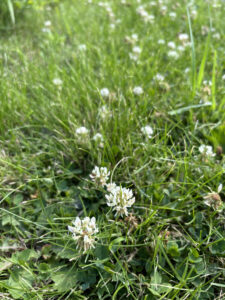
Mowers pass over low-growing clovers.
We recently discovered an amusing irony created by one of the most common lawn plants – white clover.
Sometimes called Dutch Clover, this low-growing plant graces unsprayed lawns in temperate regions across the globe. Normally, we discourage nonnative plants at Winding Pathways, but clover is an exception.
Although native to Eurasia, it’s not invasive. This important forage legume is likely the most widespread in the world. Diminutive clover is so low growing our mower passes right over its dainty flowers. Our friendly cottontail bunnies may seem to be eating grass, but actually, they’re feasting on clover. So are beneficial insects. As its flowers add beauty to the lawn and feed animals, clover’s roots pump nitrogen into the soil, helping other plants grow.
The irony
AI detected our Internet search for clover information. We began getting computer ads from landscaping companies encouraging us to hire them to kill our clover “and other weeds” in our lawn. No way!
Many people spend good money to poison beneficial lawn plants. They expose themselves, their pets, and anyone who walks on the lawn to toxic substances.
Maintaining a Healthy Bed of White Clover
White clover tends to gradually decline over the years. We’ve noticed this at Winding Pathways. To give it a boost we buy white clover seeds and sprinkle them on the lawn during cool months, especially on bare spots. Seed can be purchased online and in stores where hunters shop. These stores sell seeds beneficial to wildlife, and hunters often plant them to boost food for deer and wild turkeys.
-
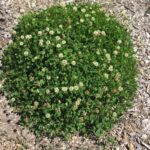
-
Clover can be manicured.
-
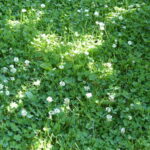
-
Sunlight on a clover lawn forms a cross.
-
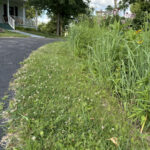
-
Dutch White Clover is low-growing.
Rewards
We have healthy lawns, rich with nitrogen. And, on summer mornings and evenings, we sit in our front porch’s rocking chairs watching bumble bees and bunnies foraging on our blooming white clovers. Thanks, clover.
-
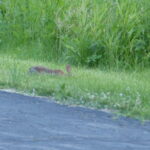
-
Bunnies enjoy clover.
-
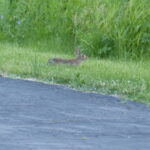
-
Watchful

































